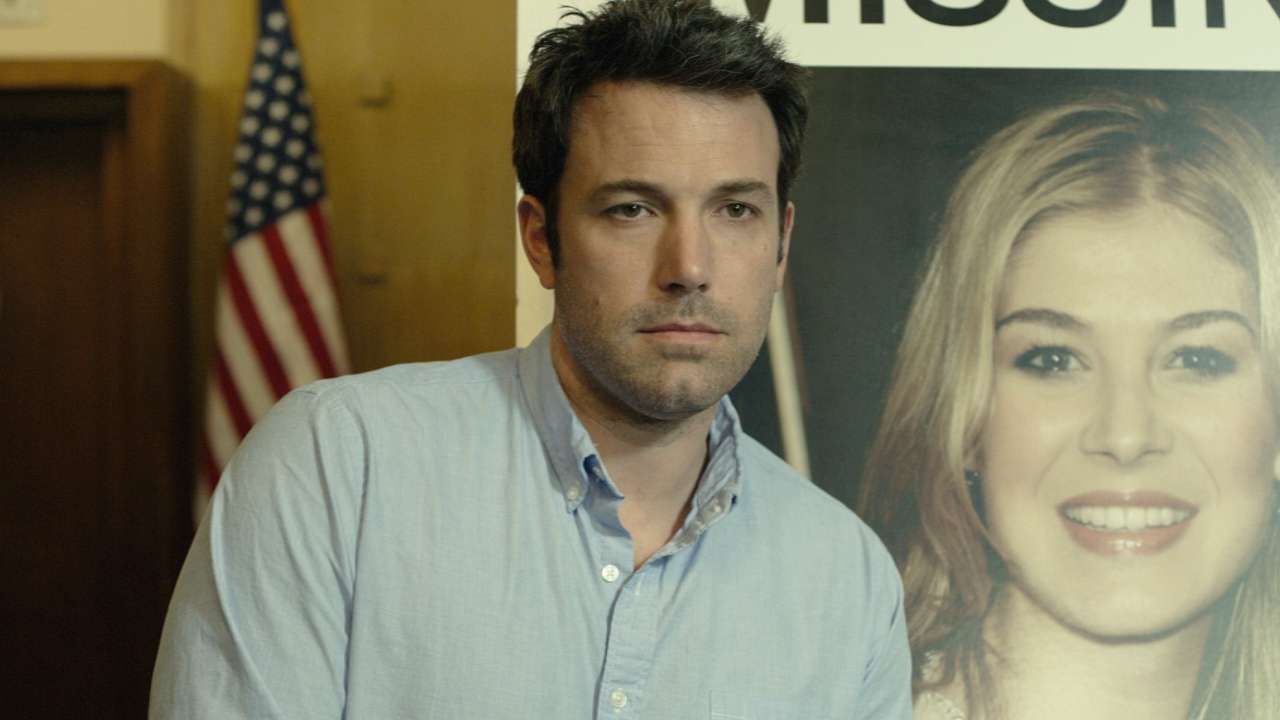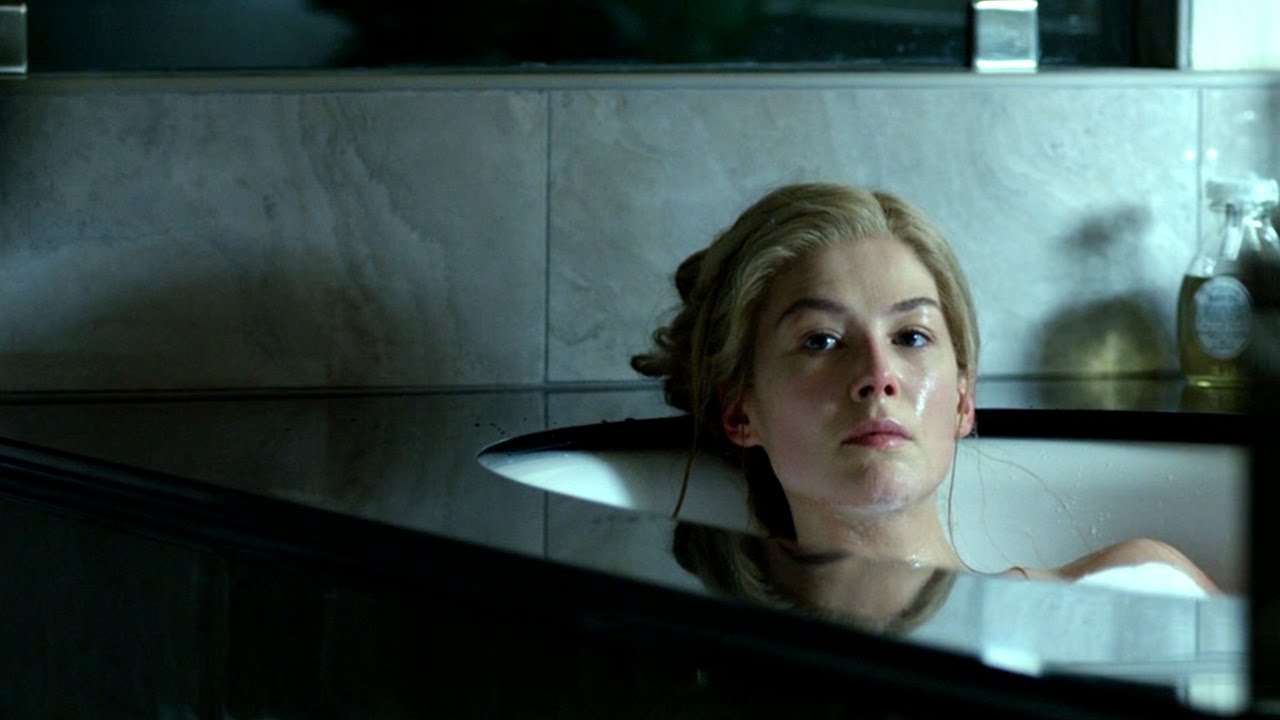Gone Girl is a 2014 American psychological thriller film directed by David Fincher and written by Gillian Flynn. It is based on her 2012 novel of the same name. Societal expectations of women are a never-ending mundane thing. A girl is expected to abide by norms and regulations. She is supposed to carry a decent smile on her face. She must never say no to her man. And she should be the belle of the ball. Yet, these are mere materialistic attributes that never make a girl prosper. In the film, Nick Dunne (Ben Affleck) discovers that the entire media focus has shifted onto him. This happens when his wife, Amy Dunne (Rosamund Pike), mystically disappears on their fifth wedding anniversary.
Recommended Read: Every David Fincher Film Ranked
Gone Girl (2014) Movie Summary & Plot Synopsis
Nick Dunne, a writing teacher, is meeting his sister Margo right before he returns home for his fifth wedding anniversary and finds his wife, Amy Dunne, missing. A flashback reveals how they met at a party, gradually fell in love, and decided to get married. Amy is known for the Amazing Amy children’s books which her parents published.
A Marriage in Decline
While the search for Amy is going on in the present, flashbacks in the form of Amy’s diary entry reveal a distorted and failed marriage. Their marriage was top-notch at the beginning. When both of them lost their jobs during the recession, they moved from New York to Missouri to support his dying mother, which Amy was reluctant to do. Before long, Nick grew distant from Amy and started to have an affair with Andie (Emily Ratajkowski), one of his students. It is also shown how Nick grew violent with small arguments and sometimes hit Amy.
Meanwhile, in the present, the media is shown to hypothesize that Nick is the kingpin of Amy’s disappearance. However, Amy used to arrange treasure hunts for their anniversary, and this time she indicated the places where Nick had sex with Andie, conveying that she was aware of Nick’s infidelity. While the police are searching for Amy, Nick’s affair with Andie doesn’t seem to have ended, although they promise to take a break until Amy is found.
The Evidence Against Nick
The forensic team and detective Rhonda Boney (Kim Dickens) find barely concealed evidence of struggle and intense blood loss in the house. Boney gets aware of financial issues, marriage disputes, and Amy’s current attempt to buy a gun. Amy’s medical report states she is pregnant, which Nick denies knowledge of because she never wanted kids. Amy’s hints lead authorities to a half-burnt diary documenting her growing fear of Nick when he starts abusing her and is seemingly violent enough to kill her.
When the audience starts to believe that Nick is responsible for apparently Amy’s murder, it is revealed that Amy is still alive and hiding in the Ozarks. She fabricated everything. She stole her pregnant neighbor’s urine, wrote a diary with forged entries, and spilled blood all over her kitchen – to obtain media sympathy. Her actual plan was to drown herself after Nick’s arrest so that he would be sentenced to death. She even cuts her hair short, dyes it, and gets a pair of specs.
Amy’s Manipulation and Return
Shortly, Nick deduced Amy’s scheme of framing him for her murder. He convinces Margo of his innocence and hires a lawyer Tanner Bolt (Tyler Perry), who bails him out later when he gets arrested on the grounds of substantial evidence. Nick decides to meet two of Amy’s former boyfriends: Tommy O’Hara (Scoot McNairy) claims he was framed for first-degree felony rape by her after he ended their relationship; and wealthy Desi Collings (Neil Patrick Harris), against whom Amy had filed a restraining order for stalking. Nevertheless, Nick decides to disclose his affair with Andie on a popular talk show when Amy gets swindled of her money by her neighbors.
Thus, she calls Desi for help, who instantly agrees to let her live in his lakehouse. Nick’s feigning regrets and shortcomings of being a spouse gathers widespread empathy among all, which he knows Amy will be watching. Amy retrieves her feelings for Nick and plans an escape- she takes advantage of the lakehouse surveillance cameras, injures her inner thighs to make it seem like Desi tried to rape her, seduces him, and slits his throat open. She returns home drenched in blood, and Nick is cleared of all the accusations.
Amy tells Nick the truth- how she killed Desi. A televised interview takes place in their home sometime later. Anticipating Nick’s intention to finally get rid of her and expose her truth, she artificially inseminates herself with Nick’s sperm and announces that she is pregnant. Nick reluctantly agrees to bind their relationship again, irrespective of whatever happened between them, for the sake of responsibilities. The screen cuts off when the camera zooms in on Amy’s face, where in between her lips, there’s a smirk, signifying she is content with the outcome.
Gone Girl (2014) Movie Themes Analysed
1. TOXIC RELATIONSHIPS AND MARRIAGE
Amy is a brilliant young woman who is shown to possess perfect-girl qualities, although it is all just a facade. Nick’s response was subpar, too; he started having an affair with Andie despite having a wife. Amy always tried to rebuild herself for Nick, groomed herself so that he would notice, and initially, their relationship and marriage were going great, but it became strained over time.
The dynamics of a relationship or a marriage is always a two-way thing. This film shows how couples can come disconnected in due course of time. Also, communication plays an essential role in a relationship. However, Nick choosing to cheat makes everything worse. There are certain expectations that Amy had for Nick; he not only shattered them but decided to be with another woman, which is why Amy became violent later, to begin with. Nevertheless, Amy is enthralled by being in charge of a relationship; she is dominating and tries to control everything besides herself.
2. PRIVATE SELVES AND PUBLIC IDENTITIES
Amy always portrayed the character of a “cool girl” despite having a dark and manipulative traits. She says, “Nick loved a girl I was pretending to be. ‘Cool girl’- men always use that, don’t they, as their defining compliment. She’s a cool girl. Cool girl is hot, Cool girl is game. Cool girl is fun, Cool girl never gets angry at her man. She only smiles in a chagrined, loving manner. She likes what he likes…”. For Nick, Amy went a lot further than she would. Her inner self is demonic where, as she publicly lets everyone speculates how much of a girly girl she is.
The film delves into the question of how we perceive ourselves and how others view us. Nick and Amy both have private and public persona and in this film, it is shown what happens when these two personalities clash in real life and how much devastating and horrific it can be.
3. DECEPTION AND FIDELITY
Fincher beautifully displayed the movie’s central themes, which are deception, manipulation, and fidelity. The film explores the theme of deception in many ways. Firstly, it highlights the deceptive nature of the media and public opinion regarding Amy’s unprecedented disappearance. The press almost declared Nick a murderer just by speculation without even comprehending the whole matter and acquiring no concrete evidence, making him seem like an abusive husband who is capable of killing her.
Secondly, manipulation out of deception is explored in Amy’s character. Amy is the mastermind of manipulation who has gone to great lengths to deceive her husband, media, police, and former partner. She fooled everyone with all those fabricated evidence.
Moreover, deception is evident in Nick’s character, too, when he tries to suppress having an affair with a younger woman and presents himself to be a loving husband, even when he is not loyal to his wife.
4. SOCIETAL GENDER ROLES AND NORMS
Society upholds certain female and male gender roles that people are expected to adhere to. Often these gender roles are gruesome and inflict personality changes in a human being. We pretend to be someone we’re not in order to get accepted in society. Amy and Nick were no different than us. They tried to fit themselves in frames which are not their shapes. Amy repeatedly attempted to be the perfect girl, whereas Nick strived to be a caring and faithful husband. Amy’s claim about being a ‘cool girl’ pretty much speaks about societal expectations of her. The movie challenges traditional gender stereotypes and questions the notion that people of all genders should behave in certain ways.
5. MEDIA AND PUBLIC OPINION
Fincher showed how media and public opinion play a vital role in semi-renowned people’s lives. For Amy, the whole ‘cool girl’ image of pretending to be cool with everything, even though she might actually be quite resentful and miserable, is draining. Amy’s character is complex and multi-layered, so apparently, the media painting her character as a victim is very unidimensional. Furthermore, the media plays a significant role in the story, as it fuels public suspicion and shapes the investigation into Amy’s disappearance.
6. VIOLENCE AND VENGEANCE
Amy was not a ‘cool girl.’ Her character was deceptive, manipulative, vindictive, and violent. Amy’s faking her own disappearance and framing Nick for her murder is a way of punishing him for his infidelity and for distorting the marriage. Nick’s deception towards Amy was pathetic, and so was Amy’s pretense of being a ‘cool girl’ for Nick. She then returned to Nick, and they both went along with the marriage where Nick promised to become a better husband. Though he initially wanted to expose Amy, he changed his mind because of her pregnancy. However, it is clear that the dynamic between the two has shifted for the worse, and Nick is now at the mercy of Amy’s manipulations.
Gone Girl (2014) Movie Ending Explained
The ending of the movie Gone Girl (2014) follows the same general trajectory as the book, with some minor changes. The film ends with Nick and Amy getting back together while choosing to live in Missouri. However, it is suggested that their relationship is still toxic and manipulative, as they both know the truth about each other and see their inner raw demonic self. Despite this, they still chose to live with each other.
The final scenes of the movie show Amy lying next to Nick, with her hand resting over his chest. The camera then zooms in on her face, and we perceive her thoughts as she contemplates the situation. Her facial expression shows that she has now fully manipulated Nick and regained control over their relationship. The film’s final shot is a close-up of Amy’s face, with a subtle smirk on her lips, manifesting that this is what she wanted, and she is content with the passive outcome.
Fincher didn’t really show where Amy and Nick go from there. Does Amy still continue living with Nick? Was Nick forgiven for his infidelity? Did Amy’s pregnancy really change them for soon-to-be parents? Audiences are given to speculating anything afterward from this movie. This film provides an open scope of thought for people. But in my opinion, there are certain possibilities that could’ve happened between them. Either they became a better individual because Amy was on the verge of pregnancy, or it could be they have finally forgiven and made peace with each other for their misdeeds and decided to part ways for the better.
Overall, the movie’s ending is intended to keep it unsettling and open to interpretation. It raises questions about toxic relationships, marriage, deception, manipulation, and the lengths people will go to retain their sense of control.








![I, Daniel Blake [2016]: A Poignant Social-Realist Drama](https://79468c92.delivery.rocketcdn.me/wp-content/uploads/2017/02/I-Daniel-Blake-cover-768x468.jpg)
